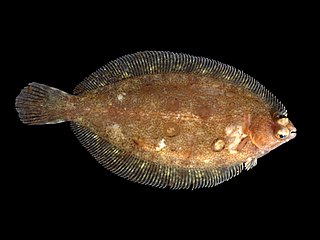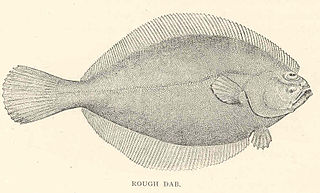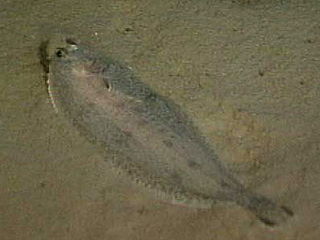
Halibut is a common name principally applied to the two flatfish in the genus Hippoglossus from the family of right-eye flounders. Less commonly, and in some regions only, other species of flatfish are also referred to as being halibuts. The word is derived from haly (holy) and butte, for its popularity on Catholic holy days. Halibut are demersal fish and are highly regarded as a food fish.

Elaeis is a genus of palms containing two species, called oil palms. They are used in commercial agriculture in the production of palm oil. The African oil palm Elaeis guineensis is the principal source of palm oil. It is native to west and southwest Africa, occurring between Angola and Gambia. The American oil palm Elaeis oleifera is native to tropical Central and South America, and is used locally for oil production.

Pleuronectidae, also known as righteye flounders, are a family of flounders. They are called "righteye flounders" because most species lie on the sea bottom on their left sides, with both eyes on their right sides. The Paralichthyidae are the opposite, with their eyes on the left side. A small number of species in Pleuronectidae can also have their eyes on the left side, notably the members of the genus Platichthys.

Microstomus is a genus of righteye flounders native to the North Pacific and Northeast Atlantic oceans.

Limanda is a genus of righteye flounders native to the northern Atlantic and Pacific oceans.

Hippoglossoides is a genus of righteye flounders native to the North Pacific and North Atlantic oceans.

Glyptocephalus is a genus of righteye flounders found in the North Atlantic and North Pacific Oceans

Platichthys is a genus of flatfish native to the North Pacific and North Atlantic oceans. Despite being in the family Pleuronectidae, both species in the genus Platichthys are often "lefteyed", i.e. they lie on the sea bottom on their right side, with both eyes on the left side.

Pseudopleuronectes is a genus of righteye flounders mostly native to the northwestern Pacific Ocean with one species (P. americanus) found in the northwestern Atlantic Ocean.

Poecilopsetta is a genus of small righteye flounders mainly found in deep water in the Indo-Pacific. Two species, P. beanii and P. inermis, are from the West Atlantic.

The Citharidae or largescale flounders are a small family of flounders with four genera. Three genera are restricted to the Indo-Pacific, while Citharus is from the Mediterranean and East Atlantic. There are a total of seven species. Species reach lengths ranging between 14 and 36 centimetres.
Arctides guineensis is a species of slipper lobster which lives in the Bermuda Triangle. It is known in Bermuda as the small Spanish lobster, a name which is also favoured by the FAO.

Bothus is a genus of flatfish in the family Bothidae from the Pacific, Indian and Atlantic Oceans. Some species in this genus have spots consisting of blue rings.

Chascanopsetta is a genus of flatfish in the family Bothidae found in deeper parts of the Pacific and Indian Oceans with a single species, C. lugubris also occurring in the Atlantic Ocean. It contains nine member species.

The scaldfishes comprise a genus, Arnoglossus, of lefteye flounders. They are found in the Pacific, Indian and Atlantic Oceans, including the Mediterranean and Black Sea. They are entirely absent from most of the Americas; the only exceptions are A. coeruleosticta and A. multirastris found off Chile. The genus include both species found in shallow and deeper water. The largest species reaches 28 cm (11 in).

Monolene is a genus of small, mainly deepwater lefteye flounders from the Atlantic and East Pacific.

Trichopsetta is a genus of small lefteye flounders native to the western Atlantic Ocean.

Citharus linguatula, the spotted flounder or Atlantic spotted flounder, is a species of fish in the Citharidae, a family of flounders. It is native to the eastern Atlantic Ocean and the Mediterranean Sea, where it is found to a depth of 300 m (980 ft). This species grows to a total length of 30 cm (12 in). It is of minor importance to local commercial fisheries. This species is the only known member of its monotypic genus.

Ancylopsetta is a genus of large-tooth flounders mostly found along the Atlantic coast of the Americas with one species found along the Pacific coast.
Xystreurys is a genus of large-tooth flounders with one species, X. liolepis, found along the Pacific coast of North America from Monterey Bay, California to the Gulf of California and the other, X. rasile, found along the Atlantic coast of South America from Rio de Janeiro, Brazil to the southern tip of Argentina.























